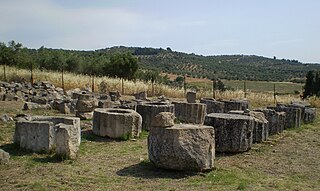 W
WAbae was an ancient town in the northeastern corner of ancient Phocis, in Greece, near the frontiers of the Opuntian Locrians, said to have been built by the Argive Abas, son of Lynceus and Hypermnestra, and grandson of Danaus. This bit of legend suggests an origin or at least an existence in the Bronze Age. Its protohistory supports a continued existence in Iron-Age antiquity. It was famous for its oracle of Apollo Abaeus, one of those consulted by Croesus, king of Lydia, and Mardonius, among others. The site of the oracle was rediscovered at Kalapodi and excavated in modern times. The results confirm an archaeological existence dating from the Bronze Age, as is suggested by the lore.
 W
WAcharaca was a village of ancient Lydia, Anatolia on the road from Tralles to Nysa on the Maeander, with a Ploutonion or a temple of Pluto, and a cave, named Charonium, where the sick were healed under the direction of the priests. There is some indication that it once bore the name Charax (Χάραξ), but that name may have belonged to Tralles. Its location is now the site of the modern town of Salavatlı. Recoveries from archaeological excavations are housed at the Aydın Archaeological Museum.
 W
WThe Aleuadae were an ancient Thessalian family of Larissa, who claimed descent from the mythical Aleuas. The Aleuadae were the noblest and most powerful among all the families of Thessaly, whence Herodotus calls its members "rulers" or "kings" (βασιλεῖς).
 W
WIn Greek mythology, Amphiaraus or Amphiaraos was the son of Oicles, a seer, and one of the leaders of the Seven against Thebes. Amphiaraus at first refused to go with Adrastus on this expedition against Thebes as he foresaw the death of everyone who joined the expedition. His wife, Eriphyle, eventually compelled him to go.
 W
WAornum was an oracle in Ancient Greece, located in Thesprotia in a cave called Charonium which gave forth poisonous vapours. The name of the cave, "Charon's Cave", reflects the belief that it was an entrance for Hades, the Greek underworld. In a version of the myth, Orpheus travels to Aornum to recover his wife, Eurydice, from Hades.
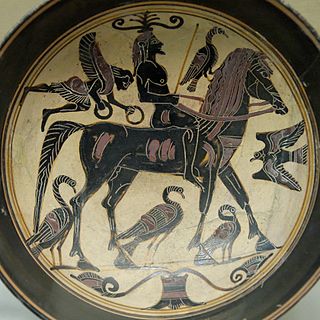 W
WAugury is the practice from ancient Roman religion of interpreting omens from the observed behavior of birds. When the individual, known as the augur, interpreted these signs, it is referred to as "taking the auspices". 'Auspices' is from the Latin auspicium and auspex, literally "one who looks at birds." Depending upon the birds, the auspices from the gods could be favorable or unfavorable. Sometimes politically motivated augurs would fabricate unfavorable auspices in order to delay certain state functions, such as elections. Pliny the Elder attributes the invention of auspicy to Tiresias the seer of Thebes, the generic model of a seer in the Greco-Roman literary culture.
 W
WCassandra or Kassandra, , was a Trojan priestess of Apollo in Greek mythology cursed to utter true prophecies, but never to be believed. In modern usage her name is employed as a rhetorical device to indicate someone whose accurate prophecies are not believed.
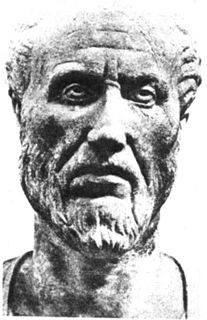 W
WThe Chaldean Oracles are a set of spiritual and philosophical texts widely used by Neoplatonist philosophers from the 3rd to the 6th century CE. While the original texts have been lost, they have survived in the form of fragments consisting mainly of quotes and commentary by Neoplatonist writers. They were likely to have originally formed a single mystery-poem, which may have been in part compiled, in part received via trance, by Julian the Chaldean, or more likely, his son, Julian the Theurgist in the 2nd century CE. Later Neoplatonists, such as Iamblichus and Proclus, rated them highly. The 4th-century emperor Julian suggests in his Hymn to the Magna Mater that he was an initiate of the God of the Seven Rays, and was an adept of its teachings. When Christian Church Fathers or other Late Antiquity writers credit "the Chaldeans", they are probably referring to this tradition.
 W
WDelphi, in legend previously called Pytho (Πυθώ), in ancient times was a sacred precinct that served as the seat of Pythia, the major oracle who was consulted about important decisions throughout the ancient classical world. The oracle was international in character and also fostered sentiments of Greek nationality, even though the nation of Greece was centuries away from realization. The ancient Greeks considered the centre of the world to be in Delphi, marked by the stone monument known as the omphalos (navel). The sacred precinct was in the region of Phocis, but its management had been taken away from the Phocians, who were trying to extort money from its visitors, and had been placed in the hands of an amphictyony, or committee of persons chosen mainly from Central Greece. According to the Suda, Delphi took its name from the Delphyne, the she-serpent (drakaina) who lived there and was killed by the god Apollo.
 W
WDidyma was an ancient Greek sanctuary on the coast of Ionia in the domain of the famous city of Miletus. Apollo was the main deity of the sanctuary of Didyma, also called Didymaion. But it was home to both of the temples dedicated to the twins Apollo and Artemis. Other deities were also honoured within the sanctuary. The Didymaion was well renowned in antiquity because of its famed oracle. This oracle of Apollo was situated within what was, and is, the one of the world's greatest temples to Apollo. The remains of this Hellenistic temple belong to the best preserved temples of classical antiquity. Besides this temple other buildings existed within the sanctuary which have been rediscovered recently; a Greek theatre and the foundations of the above-mentioned Hellenistic temple of Artemis, to name but two.
 W
WDodona in Epirus in northwestern Greece was the oldest Hellenic oracle, possibly dating to the second millennium BCE according to Herodotus. The earliest accounts in Homer describe Dodona as an oracle of Zeus. Situated in a remote region away from the main Greek poleis, it was considered second only to the Oracle of Delphi in prestige.
 W
WEgeria was a nymph attributed a legendary role in the early history of Rome as a divine consort and counselor of Numa Pompilius, the second king of Rome, to whom she imparted laws and rituals pertaining to ancient Roman religion. Her name is used as an eponym for a female advisor or counselor.
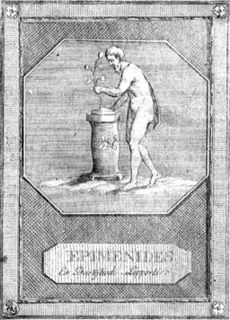 W
WEpimenides of Cnossos was a semi-mythical 7th or 6th century BC Greek seer and philosopher-poet, from Knossos or Phaistos.
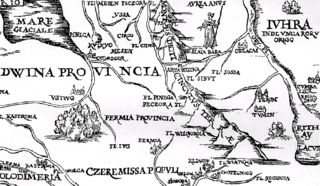 W
WThe Golden Woman, Golden Hag, Golden Lady is a legendary idol, an alleged item of worship of the indigenous peoples of Northeastern Europe/Northwestern Siberia. Early references about it are contradictory, both in its geographical location and in description.
 W
WGryneium or Gryneion, also Grynium or Grynion (Γρύνιον), Grynia or Gryneia (Γρύνεια) and Grynoi (Γρῦνοι), was a city of ancient Aeolis. It was located 40 stadia from Myrina and 70 from Elaea. In early times it was independent, one of the 12 important cities of Aeolis, but afterwards became subject to Myrina. It contained a sanctuary of Apollo with an ancient oracle and a splendid temple of white marble. Pausanias wrote that at Gryneium, where there was an amazing grove of Apollo, with cultivated trees, and all those which, although they bear no fruit, are pleasing to smell or look upon.
 W
WThe Ancient Greek aphorism "know thyself" is one of the Delphic maxims and was the first of three maxims inscribed in the pronaos (forecourt) of the Temple of Apollo at Delphi according to the Greek writer Pausanias (10.24.1). The two maxims that followed "know thyself" were "nothing to excess" and "certainty brings insanity". In Latin the phrase, "know thyself", is given as nosce te ipsum or temet nosce.
 W
WLivadeia is a town in central Greece. It is the capital of the Boeotia regional district. Livadeia lies 90 km (56 mi) north-west of Athens, 64 km (40 mi) west of Chalkida, 63 km (39 mi) south-east of Lamia, 44 km (27 mi) east-south-east of Amfissa, and 91 km (57 mi) east-north-east of Nafpaktos. The town lies some five kilometres west of Greek National Road 3, to which it is linked by National Road 48.
 W
WPythia was the priestess presiding over the Oracle of Apollo at Delphi. There are more than 500 supposed oracular statements which have survived from various sources referring to the oracle at Delphi. Many are anecdotal, and have survived as proverbs. Several are ambiguously phrased, apparently in order to show the oracle in a good light regardless of the outcome. Such prophecies were admired for their dexterity of phrasing. The following list presents some of the most prominent and historically significant prophecies of Delphi.
 W
WNyx is the Greek goddess of the night. A shadowy figure, Nyx stood at or near the beginning of creation and mothered other personified deities such as Hypnos (Sleep) and Thanatos (Death), with Erebus (Darkness). Her appearances are sparse in surviving mythology, but reveal her as a figure of such exceptional power and beauty that she is feared by Zeus himself.
 W
WOld Babylonian oracle is a Sumerian myth, written on clay tablets dated to between 2340 and 2200 BC.
 W
WIn Greek mythology, Pasiphaë was a queen of Crete. The daughter of Helios and the Oceanid nymph Perse, Pasiphaë is notable for being the mother of the Minotaur, whom she conceived after mating with the Cretan Bull hidden within a hollow cow that the Athenian inventor Daedalus built for her, after the god Poseidon cursed her to fall in love with the beast. The curse was sent after her husband Minos failed to sacrifice to Poseidon the bull as he had promised.
 W
WNuma Pompilius was the legendary second king of Rome, succeeding Romulus after a one-year interregnum. He was of Sabine origin, and many of Rome's most important religious and political institutions are attributed to him, such as the Roman calendar, Vestal Virgins, the cult of Mars, the cult of Jupiter, the cult of Romulus, and the office of pontifex maximus.
 W
WEl Puerto de Santa María, locally known as El Puerto, is a municipality located on the banks of the Guadalete River in the province of Cádiz, Andalusia. As of 2016, the city has a population of c. 88,184, of which some 50,000 live in the urban center, and the remainder in the surrounding areas.
 W
WThe Pythia was the name of the high priestess of the Temple of Apollo at Delphi who also served as its oracle, also known as the Oracle of Delphi. Her title was also historically glossed in English as the Pythoness.
 W
WSelf-praise of Shulgi is a Sumerian myth, written on clay tablets dated to between 2100 and 2000 BC.
 W
WThe sibyls were prophetesses or oracles in Ancient Greece. The earliest sibyls, according to legend, prophesied at holy sites. Their prophecies were influenced by divine inspiration from a deity, originally at Delphi and Pessinos. In Late Antiquity, various writers attested to the existence of sibyls in Greece, Italy, the Levant, and Asia Minor.
 W
WThe Sibylline Books were a collection of oracular utterances, set out in Greek hexameters, that, according to tradition, were purchased from a sibyl by the last king of Rome, Tarquinius Superbus, and were consulted at momentous crises through the history of the Republic and the Empire. Only fragments have survived, the rest being lost or deliberately destroyed.
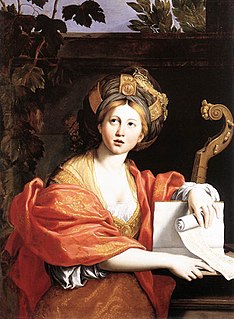 W
WThe Sibylline Oracles are a collection of oracular utterances written in Greek hexameters ascribed to the Sibyls, prophetesses who uttered divine revelations in a frenzied state. Fourteen books and eight fragments of Sibylline Oracles survive, in an edition of the 6th or 7th century AD. They are not to be confused with the original Sibylline Books of the ancient Etruscans and Romans which were burned by order of the Roman general Flavius Stilicho in the 4th century AD. Instead, the text is an "odd pastiche" of Hellenistic and Roman mythology interspersed with Jewish, Gnostic and early Christian legend.
 W
WThe Siwa Oasis is an urban oasis in Egypt between the Qattara Depression and the Great Sand Sea in the Western Desert, 50 km (30 mi) east of the Libyan border, and 560 km (348 mi) from Cairo. About 80 km (50 mi) in length and 20 km (12 mi) wide, Siwa Oasis is one of Egypt's most isolated settlements with about 33,000 people, mostly Berbers, who developed a unique and isolated desert culture and a language called Siwi; they are also fluent in the Egyptian dialect of Arabic which is called "Masry" meaning Egyptian.
 W
WTages was claimed as a founding prophet of Etruscan religion who is known from reports by Latin authors of the late Roman Republic and Roman Empire. He revealed a cosmic view of divinity and correct methods of ascertaining divine will concerning events of public interest. Such divination was undertaken in Roman society by priestly officials called haruspices.
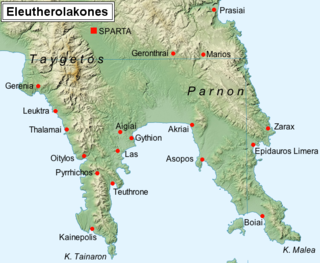 W
WThalamae or Thalamai was a town of ancient Laconia, which at various times belonged to Messenia.
 W
WThe Thriae were nymphs, three virginal sisters, one of a number of such triads in Greek mythology. They were named Melaina, Kleodora, and Daphnis ("Laurel") or Corycia.
 W
WIn Greek mythology, Tiresias was a blind prophet of Apollo in Thebes, famous for clairvoyance and for being transformed into a woman for seven years. He was the son of the shepherd Everes and the nymph Chariclo. Tiresias participated fully in seven generations in Thebes, beginning as advisor to Cadmus himself.
 W
WXenoclea, who appears as a character in the legend of Hercules, was the Pythia, or priestess and oracle, of the temple of Apollo at Delphi.